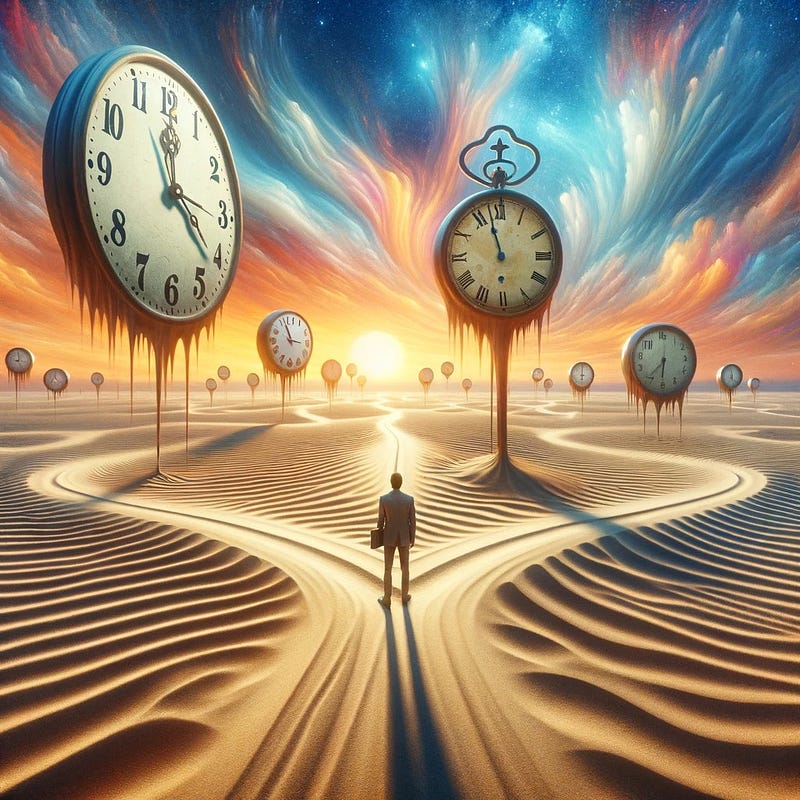Exploring Time: The Fascinating Link Between Light Speed and Time
Written on
Chapter 1: Introduction to Time and Light Speed
Time, a constant yet elusive dimension, has intrigued humanity for ages. From ancient timekeeping devices like sundials to today’s precise atomic clocks, our pursuit of understanding time has been relentless. This curiosity extends into science fiction, where the idea of time travel sparks our imagination with the potential to revisit the past or glimpse into the future. Central to these ideas is a critical question: Is it possible to navigate through time as we do through space? The answer may lie in the mysteries surrounding the speed of light.
The speed of light, estimated at about 299,792 kilometers per second, is more than just a velocity measurement; it represents a fundamental boundary in the universe. According to contemporary physics, no object with mass can exceed this speed. This cosmic limitation is embedded in the very fabric of space and time and forms a crucial part of Albert Einstein's relativity theory. His groundbreaking concepts reshaped our understanding of time and space, demonstrating that they are intricately connected rather than separate entities.
One of relativity's most profound insights is the way speed influences time itself. As an object approaches the speed of light, time appears to slow down for that object from the viewpoint of an outside observer. This phenomenon, known as time dilation, carries significant implications. It posits that at light speed, time would theoretically come to a halt. This isn't merely a theoretical idea; it has real-world applications, as evidenced by GPS satellites that must account for time dilation effects due to their high velocities compared to Earth.
In this complex interplay of light and time, we find ourselves at the edge of understanding, navigating between established physics and the vast mysteries of the cosmos. As we explore these concepts further, we begin to unravel one of existence's most compelling enigmas: the very nature of time.

Chapter 2: Time Dilation and The Possibility of Exceeding Light Speed
Time dilation, a captivating idea stemming from Einstein's theory of relativity, illustrates how time can be stretched or compressed based on an observer's relative speed. Picture yourself aboard a spacecraft traveling near light speed; while time feels normal for you, an observer on Earth would see your clock ticking more slowly. This is not a mere fantasy; it is a scientifically validated phenomenon. For example, astronauts on the International Space Station experience time slightly differently than we do on Earth, despite the minute difference due to the ISS's much lower speed compared to light speed.
The implications of time dilation prompt even more fascinating inquiries when we consider the notion of traveling faster than light. Although this remains beyond our current technological capabilities and possibly in violation of physical laws, the concept ignites the imagination. If traveling at light speed slows down time, could surpassing that speed reverse time? This hypothetical scenario opens a plethora of paradoxes and challenges. If one could journey back in time, it raises the question of whether altering past events is possible – a concept that contradicts our understanding of causality. The "grandfather paradox," a well-known thought experiment, encapsulates this dilemma: if you travel back and prevent your grandfather from meeting your grandmother, would you cease to exist?
Despite these mind-bending implications, the idea of exceeding light speed remains an enticing possibility. It pushes the limits of our understanding and invites us to reconsider the very nature of reality. Scientists are actively investigating the realms of quantum mechanics and theoretical physics, where classical physics rules may be bent in unexpected ways. As we delve deeper into these mysteries, the line between science and science fiction blurs, revealing a universe more strange and wonderful than we ever imagined.
This video titled "Do we travel through time at the speed of light?" delves into the intriguing relationship between light speed and time travel, offering insights into the scientific theories that underpin these concepts.
In the video "Do photons experience time?", we explore how light particles interact with time, shedding light on the complexities of time as understood through quantum physics.
Chapter 3: Quantum Physics and Its Influence on Time Perception
In the pursuit of understanding time, quantum physics provides a markedly different perspective from classical physics. Quantum mechanics, characterized by particles appearing and disappearing and being entangled over vast distances, suggests that time may behave in ways we have yet to fully comprehend. Theories like quantum entanglement challenge the traditional concept of linear time. Some physicists speculate that, at the quantum level, time could flow backward or exist in a state of superposition, akin to the peculiar behavior of quantum particles.
This quantum viewpoint introduces a new dimension to our understanding of time. Recent experiments indicate that, under specific conditions, particles seem to "know" about future changes, hinting at a complex interplay between time and quantum phenomena. While these ideas are still emerging and mired in theoretical complexity, they signify a transformative shift in how we perceive time, potentially leading to groundbreaking discoveries in physics.
The investigation of time in physics significantly influences our human perception of it. Our daily experiences portray time as a constant, linear progression, yet these scientific revelations present a different narrative, one where time is flexible, multi-layered, and profoundly mysterious. This not only captivates us but also invites philosophical reflection about our role in the universe. How does the fluidity of time shape our understanding of existence, free will, and our transient nature? Exploring these questions bridges science and philosophy, encouraging deeper contemplation of our temporal existence.
As we continue to explore these realms, our perception of time evolves, reshaping our understanding of reality itself. Time, it appears, is not merely a dimension we traverse; it is a complex, dynamic entity that we are just beginning to decipher. The journey to unravel its mysteries continues to inspire and challenge us, pushing the boundaries of both science and imagination.

Chapter 4: Conclusions and Future Directions
Ultimately, our exploration of time dilation, the speed of light, and the quantum domain reveals a universe much more intricate and enigmatic than our everyday experiences suggest. We find ourselves at a pivotal moment in history, where the distinctions between science, philosophy, and fiction are increasingly blurred. The investigation of time, particularly concerning light speed and quantum mechanics, challenges our fundamental grasp of reality and opens up endless possibilities for the future.
Though time travel remains a mainstay of science fiction, scientific inquiries into the nature of time encourage us to think beyond conventional boundaries. They remind us that the universe operates according to laws and phenomena that are often counterintuitive and immensely fascinating. As we continue to explore these enigmas, we expand our knowledge and push the limits of scientific understanding.
This exploration transcends mere academic curiosity; it touches the very core of our existence. It compels us to reflect on profound questions about the essence of existence, our perception of reality, and our position in the cosmos. As we persist in unraveling the intricate nature of time, we pave the way for future generations to explore, comprehend, and perhaps one day, navigate the very fabric of time itself.
References
- Einstein, A. (1905). "On the Electrodynamics of Moving Bodies", Annalen der Physik.
- Hawking, S. (1988). "A Brief History of Time", Bantam Books.
- Greene, B. (2004). "The Fabric of the Cosmos: Space, Time, and the Texture of Reality", Vintage Books.
- Kaku, M. (2008). "Physics of the Impossible: A Scientific Exploration into the World of Phasers, Force Fields, Teleportation, and Time Travel", Doubleday.
- Rovelli, C. (2017). "The Order of Time", Riverhead Books.
- "Experimental quantum 'time travel' defies 'no-go' theorem", Nature, 2019.
- Overbye, D. (2020). "Astronauts and the Distortion of Time: Understanding Time Dilation", The New York Times.
- "The Quantum Mechanics of Time Travel Through Post-Selected Teleportation", Physical Review Letters, 2017.
As we progress in our quest to comprehend time, each new revelation opens doors to realms once deemed purely imaginative. The distinction between what is scientifically feasible and what remains in the realm of fiction grows increasingly tenuous, reminding us of the endless wonders that the universe has in store.
